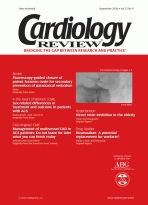Heart failure with preserved ejection fraction in women
Heart failure in the United States affects 4.9 million people, of whom 2.5 million are women.
Heart failure in the United States affects 4.9 million people, of whom 2.5 million are women. More than 1 million hospital discharges are attributed to heart failure, and heart failure is the leading cause of hospitalization in patients over the age of 65 years. Compared with men, women exhibit differences in epidemiology, symptoms, response to treatment, and outcomes in heart failure. Heart failure with preserved ejection fraction (HF-PEF), otherwise known as diastolic heart failure, has long been considered a disease of elderly women. The differential effects of sex hormones on the myocardial hypertrophic response may account for the greater incidence of HF-PEF in women. In women, left ventricular mass increases with age but decreases in men, and women have a more dramatic hypertrophic response to increased myocardial work load and injury. However, HF-PEF is now becoming increasingly recognized as a cause of heart failure in men. The prevalence of HF-PEF increases with age, and although prognosis is poor, it is better than in systolic dysfunction heart failure. Little is known regarding sex differences in etiology and symptoms in patients with HF-PEF.
Cardiology Review
In this issue of , Deswal and colleagues examined sex differences in clinical presentation, hospitalization, and mortality among subjects with HF-PEF using the ancillary arm of the Digitalis Investigation Group study. They analyzed 719 patients, of whom 341 were women. They found that women with HF-PEF were older and had more comorbidities, such as diabetes and renal insufficiency. Women also had greater clinical severity of heart failure, had more frequent symptoms and signs of heart failure, and were more likely to be treated with diuretics. This is one of the largest sex difference studies in HF-PEF patients. Surprisingly, ischemia was identified as the primary cause of heart failure in women. Past studies have shown that coronary heart disease, hypertension, idiopathic dilated cardiomyopathy, and valvular heart disease are the most common causes of heart failure in both sexes; however, the relative roles of these diseases are different in men and women. Initially, hypertension was thought to be the most important cause of HF-PEF in women. Thus, it is a new finding to learn that ischemia is the most common cause of HF-PEF in women. This is probably due to increasing age and prevalence of coronary heart disease among women with heart failure.
There have been conflicting reports regarding sex and survival, but overall, both registry studies and trials have shown that women have a lower mortality rate than men. This is confirmed in the current study as well. During a median follow-up period of 39 months, unadjusted mortality was similar in women and men, but more women were hospitalized for heart failure. After adjustment for baseline differences, female sex was an independent predictor of lower mortality. Regardless of sex, this study shows the high rate of cardiovascular mortality in subjects with HF-PEF.
Finally, as in other studies of women and heart failure, Deswal and colleagues found that women with HF-PEF continue to have high rates of hospitalization and greater lifestyle limitation because of heart failure. Women with HF-PEF also have poorer control of blood pressure compared with their male counterparts. This, again, emphasizes the need to aggressively treat women with heart disease.
